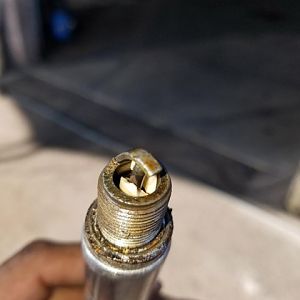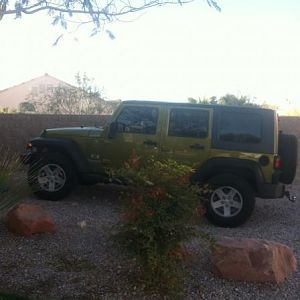A dirty throttle body (henceforth "TB") can cause a variety of symptoms including:
1. Tendency to stall when stepping on the gas (especially from a cold start), while the car is in gear and idling
2. Gagging acceleration (until engine gets to running temp)
3. Fluttering gear changes
4. "Banging" into 2nd gear
5. Growling WOT
Clean the TB thoroughly.
1. If you have a 2002-2004, the throttle should be controlled by a braided cable. Two of them actually on my KJ (the 2nd cable goes to cruise control, so you might only have 1 without cruise control).
2. If you have a cable-controlled throttle, it only takes about 10 minutes to pop the hood, remove the intake ducting to expose the TB,
2.1 Disconnect the TPS (throttle position sensor) and IACV (idle air control valve). DO NOT BREAK THE LOCKING TABS. If it turns out they are already broken, buy replacements. Go slow and use your marbles.
2.2 Disconnect the braided throttle control cables (there will be 2 if you have cruise control).
2.3 Unscrew the three 8mm bolts that hold the TB in place. Be careful not to drop anything into the gaps in the manifold, spread a cloth around the base of the throttle as a precaution before you start unscrewing anything.
3. There is a special gasket (looks like opaque white silicon to me) that creates an airtight seal between the base of the TB and the manifold intake. Make sure that is nice and healthy looking. Leave it stuck in the manifold.
4. Once the TB is out, *remove the TPS and IACV sensors* from the TB. This is very important because cleaning solutions are generally a mixture of acetone and toluene, which will eat anything that is plastic, and that is 95% of what the sensors are made of. Be careful to not strip or snap-off the star-head screws used for the sensors. NOTE: the IACV *does have* an o-ring that you must hang onto for reattachment, the TPS *does not* have any o-ring, make sure you account for that IACV o-ring, make sure it isn't stuck in the TB, and do not let it drop into the manifold!
4. You should end up with an aluminum bare-metal TB. Now work that over with CRC Throttle Cleaner...
https://www.autozone.com/fuel-and-e...50001289410&CADevice=c&gad_source=1&gclsrc=ds
...use lots of q-tips, terry towel rags, brass brushs, toothbrushes, whatever until all old residue is gone. There are a couple of pass-thru ports that you must thoroughly ream out. Keep at it until all buildup is gone.
5. Put everything back in reverse order. Attach the sensors to the TB (hand tight plus 1/4 turn or so) remembering to seat that IACV o-ring properly otherwise you will have a vacuum leak, attach TB to manifold by setting screws to finger-tight, and then in a circular pattern progressively tighten the 3 screws to 100 ***INCH***/lbs (per manual) which is equivalent to 8.33 ft/lbs. Reattach sensor cables, vacuum hoses, intake duct, etc.
6. Recommended option, replace the Intake Air Temp sensor too as long as you are at it ($25 kit from Autozone that includes the sensor and the connector pigtail). Top of manifold same side as TPS and IACV. Use dielectric grease on sensor connectors, see YouTube for examples of application.
1. Tendency to stall when stepping on the gas (especially from a cold start), while the car is in gear and idling
2. Gagging acceleration (until engine gets to running temp)
3. Fluttering gear changes
4. "Banging" into 2nd gear
5. Growling WOT
Clean the TB thoroughly.
1. If you have a 2002-2004, the throttle should be controlled by a braided cable. Two of them actually on my KJ (the 2nd cable goes to cruise control, so you might only have 1 without cruise control).
2. If you have a cable-controlled throttle, it only takes about 10 minutes to pop the hood, remove the intake ducting to expose the TB,
2.1 Disconnect the TPS (throttle position sensor) and IACV (idle air control valve). DO NOT BREAK THE LOCKING TABS. If it turns out they are already broken, buy replacements. Go slow and use your marbles.
2.2 Disconnect the braided throttle control cables (there will be 2 if you have cruise control).
2.3 Unscrew the three 8mm bolts that hold the TB in place. Be careful not to drop anything into the gaps in the manifold, spread a cloth around the base of the throttle as a precaution before you start unscrewing anything.
3. There is a special gasket (looks like opaque white silicon to me) that creates an airtight seal between the base of the TB and the manifold intake. Make sure that is nice and healthy looking. Leave it stuck in the manifold.
4. Once the TB is out, *remove the TPS and IACV sensors* from the TB. This is very important because cleaning solutions are generally a mixture of acetone and toluene, which will eat anything that is plastic, and that is 95% of what the sensors are made of. Be careful to not strip or snap-off the star-head screws used for the sensors. NOTE: the IACV *does have* an o-ring that you must hang onto for reattachment, the TPS *does not* have any o-ring, make sure you account for that IACV o-ring, make sure it isn't stuck in the TB, and do not let it drop into the manifold!
4. You should end up with an aluminum bare-metal TB. Now work that over with CRC Throttle Cleaner...
https://www.autozone.com/fuel-and-e...50001289410&CADevice=c&gad_source=1&gclsrc=ds
...use lots of q-tips, terry towel rags, brass brushs, toothbrushes, whatever until all old residue is gone. There are a couple of pass-thru ports that you must thoroughly ream out. Keep at it until all buildup is gone.
5. Put everything back in reverse order. Attach the sensors to the TB (hand tight plus 1/4 turn or so) remembering to seat that IACV o-ring properly otherwise you will have a vacuum leak, attach TB to manifold by setting screws to finger-tight, and then in a circular pattern progressively tighten the 3 screws to 100 ***INCH***/lbs (per manual) which is equivalent to 8.33 ft/lbs. Reattach sensor cables, vacuum hoses, intake duct, etc.
6. Recommended option, replace the Intake Air Temp sensor too as long as you are at it ($25 kit from Autozone that includes the sensor and the connector pigtail). Top of manifold same side as TPS and IACV. Use dielectric grease on sensor connectors, see YouTube for examples of application.










